How to build a two-story aerated concrete house with your own hands? How to build a two-story log house with your own hands
So, you came to the conclusion that the family does not need an apartment, but their own land plot, a quiet house without neighbors sniffing behind the wall, a small garden for the pleasant chores of an amateur gardener. But how to build a house? The problem is solved in two ways: build it yourself or turn to professionals. If you decide on the first, then you will have to master just a huge amount of information in specialized forums in a short time. And this article is intended specifically for those who need to "remember the theory" for a conversation with representatives of a construction company.
What are the first questions you should ask yourself if you are thinking about how to build a house?
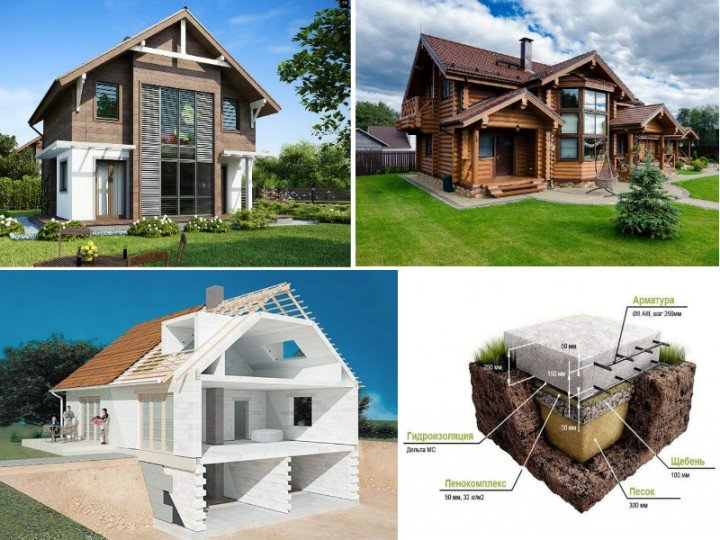
All further questions and answers depend on this. You can save up for every brick, like godmother Pumpkin, get a mortgage, stretch the construction site for ten years, etc.
Video: How much does it cost to build a brick house
2. How to find a suitable land plot?
Finding a place for your future home is not an easy task, online boards and local newspaper ads will come to the rescue. Do not forget about, firstly, practicality issues: there should be access roads nearby, the necessary energy carrier routes (water, gas, electricity). It is better to live as far as possible from garbage heaps, cemeteries, industrial plants, etc. And secondly, about the emotional moment - you must fall in love with the chosen place, because now your home will be here.

3. How to build a house: where to find a project
Go to the websites of construction companies and design organizations. Now on the Internet there are a huge number of standard projects, from which you will have to choose those options that will appeal to all family members. If everything does not suit you, then you need to order an individual project. When choosing, you need to consider what kind of foundation, roofing and material will be used for this house.

How to choose a house project. Video
4. What material is better to build a house from?
You have to decide for yourself, based on funds and personal preferences. The main advantages and disadvantages of various building materials will be summarized below:
A) Wood (log - rounded and hewn, profiled timber - regular and glued)

Advantages:
- the house "breathes";
- the optimal humidity level for a person is maintained inside (at least 50%);
- savings on finishing;
- lower cost of the foundation compared to other options;
- natural, environmentally friendly material;
- on a subconscious level, it is immediately perceived as a warm and comfortable home.
Flaws:
- it is necessary to process with all kinds of chemical impregnations in order to reduce the risk of destruction of logs by woodworms, mold, fire;
- all wooden blanks tend to crack (with the exception of glued beams);
- over the next few years, it shrinks (except for glued beams), which delays construction and does not allow moving on to the installation of windows / doors and the stage of interior decoration.
B) Brick (silicate and ceramic)
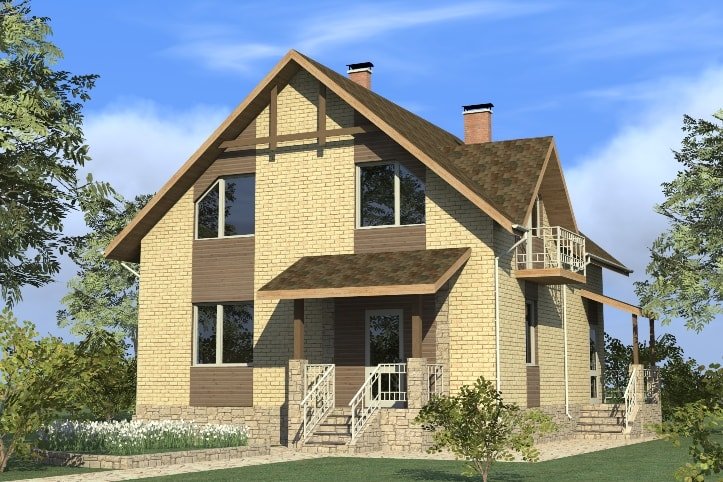
Advantages:
- the continuity of the walls;
- the house "breathes";
- resistant to fire;
- low risk of fungal infection;
- not of interest to rodents.
Flaws:
- low thermal insulation properties;
- need an expensive deep foundation;
- may crack during shrinkage;
- low frost resistance.
C) Foam block, or cellular concrete (polystyrene, gas, expanded clay, foam concrete)
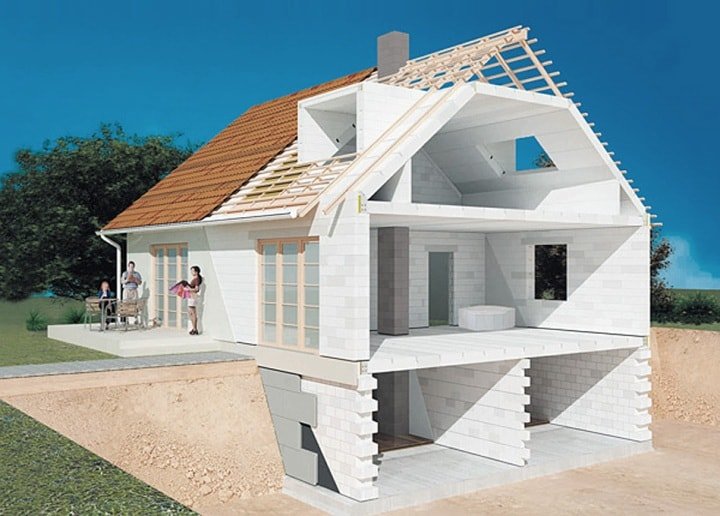
Advantages:
- one block is equal to 17 ordinary bricks, which greatly speeds up the process of forcing the box;
- the cost of the house is lower than the previous two;
- the material has high thermal insulation properties;
- lower foundation costs than a brick house.
Flaws depend on the type of material:
- absorbs moisture too well due to porosity, leading to further cracks ( gas silicate blocks);
- interior finishing work can be started only after the house dries well (gas silicate blocks);
- in the walls of foam concrete, metal doors and forged window grilles do not hold well;
- a house made of polystyrene concrete "does not breathe", additional ventilation is needed.
D) By frame ("Canadian") technology

Advantages:
- low cost;
- speed of erection of the frame;
- high thermal insulation of the house;
- lungs Construction Materials.
Flaws
- it is impossible to combine a frame-panel house and foam insulation, otherwise rodents can make a sieve out of the house;
- artificial material, the safety of which is still in question.
5. What is the best number of storeys of the house?
It depends on the construction budget and the size of the plot. If there is little land, and the family is large, then a two-story building is preferable. Usually houses up to 100 sq.m. - one-story, and more than 200 sq.m. - double storey.
Two-storey house

Advantages:
- cost of 1 sq.m. lower than when building one-story house;
- the sleeping area on the second floor is always warmer;
- looks more solid.
Flaws:
- high cost of stairs;
- a flight of stairs reduces the living space of the house;
- costs for the second bathroom;
- in summer it is noticeably hotter on the second floor than on the first;
- children or elderly family members may trip and fall down the stairs;
- few people go up to the second floor during the day.
Cottage
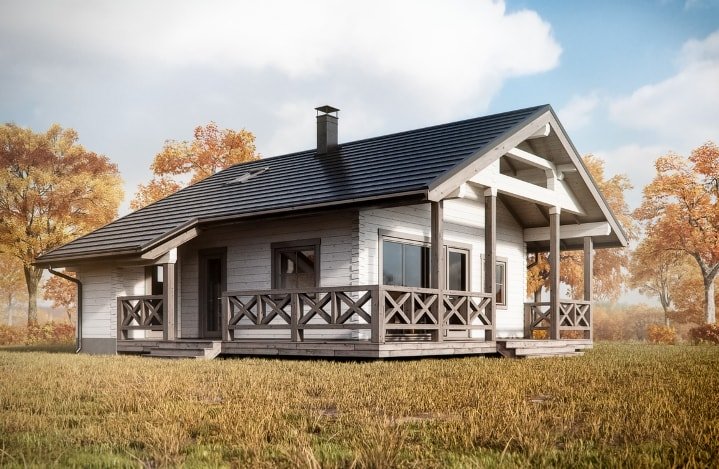
Advantages:
- built faster than a two-story;
- it is easier to repair;
- simple system heating.
Flaws:
- very complex layout with a large number of little-used walk-through rooms;
- foundation costs may be higher than those of a two-story house due to the larger perimeter of the house;
- likewise higher roofing costs.
6. Which foundation to choose?
There are the following kinds:
A) floating or slab
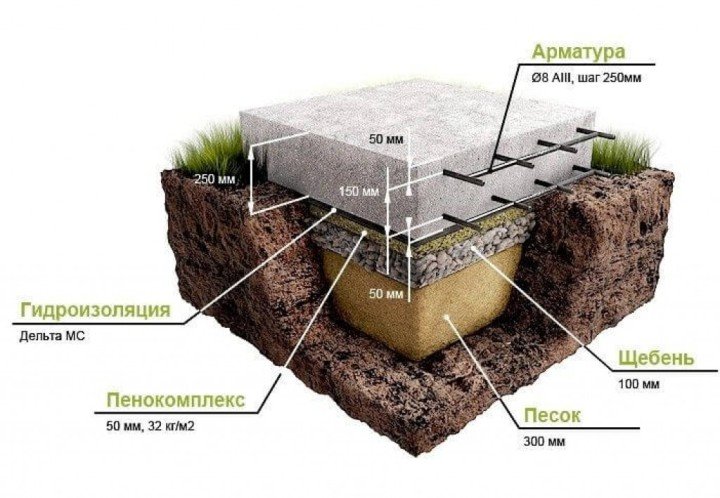
- thanks to a single slab under the house, a rigid structure is obtained;
- the slab is laid directly on the ground;
- foundation is expensive a large number steel structures and concrete.
B) Tape
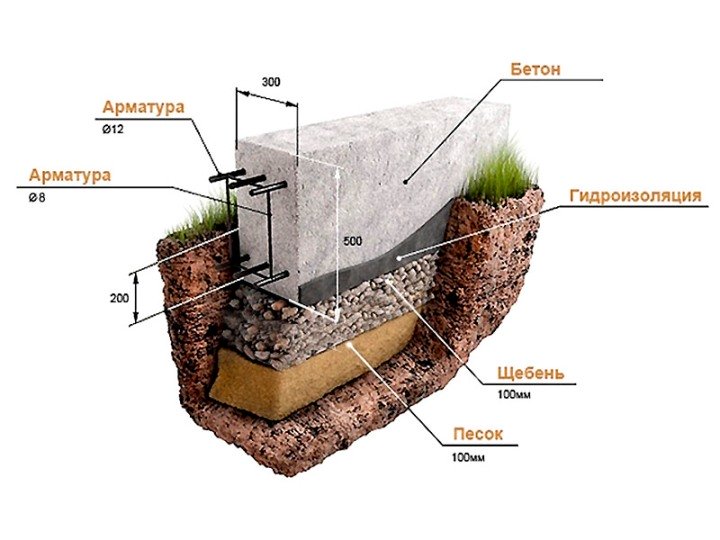
- continuous around the entire perimeter of the house;
- used for all types of houses;
- suitable for a house with a large area;
- durable and solid foundation where the load is distributed evenly;
- it needs a lot of building materials;
- subspecies: rubble masonry and rubble concrete;
- the strip foundation is predominantly of a simple geometric shape.
B) columnar

- quickly installed and has high reliability;
- low cost of the foundation;
- waterproofing is not needed;
- suitable for buildings with low load (for frame house, dachas, baths) and freezing soil;
- not suitable for soils prone to movement or heaving;
- in houses with such a foundation there will be no basement;
- cannot be used for heavy buildings.
D) pile, or bored
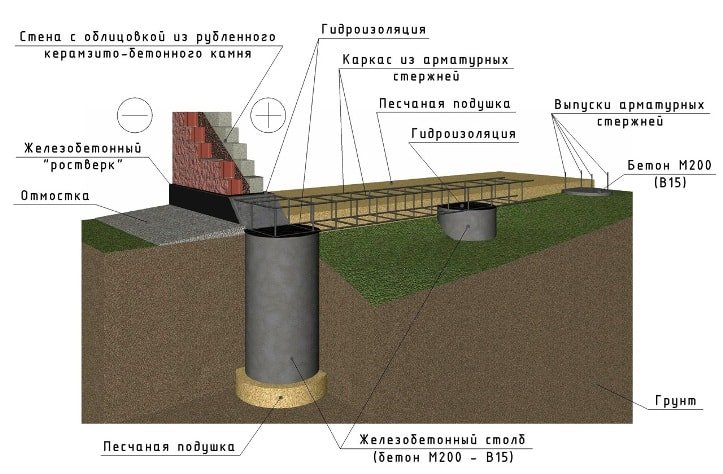
- subspecies column foundation;
- the structure consists of reinforced concrete piles filled with concrete and a concrete grillage resting on the piles;
- load-bearing elements are located at the corners of the house, under the intersection of load-bearing walls, the base of the fireplace, etc.;
- suitable for soil with a high level of moisture and other difficult soils;
- it is used for light structures (frame house, small cottage or bath).
D) pile screw

- used for complex soils and uneven surfaces;
- the structure consists of pipes (piles) with a sharp end, which are twisted to the required depth. A grillage from a bar or channel is fixed from above;
- low cost of the foundation;
- installed very quickly.
7. Which roof to choose?
Exists two main types:
- pitched, or attic. They consist of a base - a solid base or a crate, a middle part - rafters, an upper part, i.e. roofs. The shape of the roof can be one-, two-, three-, four- and multi-pitched;
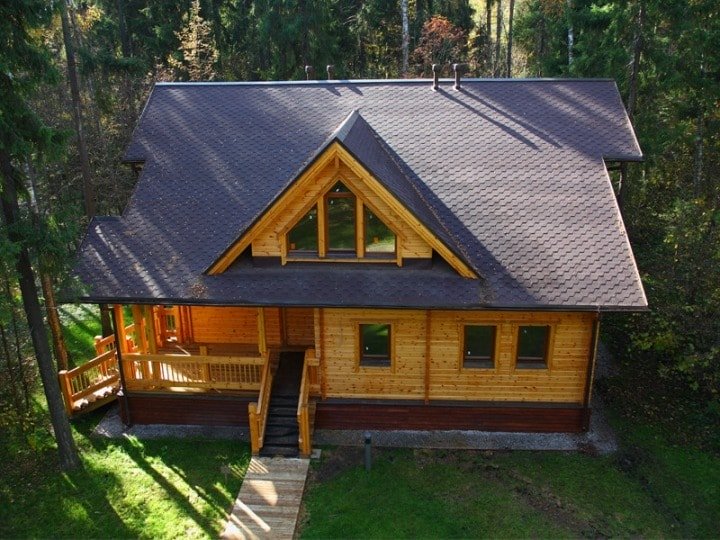
- unattractive. This is a flat roof, where roofing materials are laid directly on the ceiling of reinforced concrete slabs, heat and vapor barrier coating. For cottages, this type is rarely chosen, more - for multi-storey buildings.
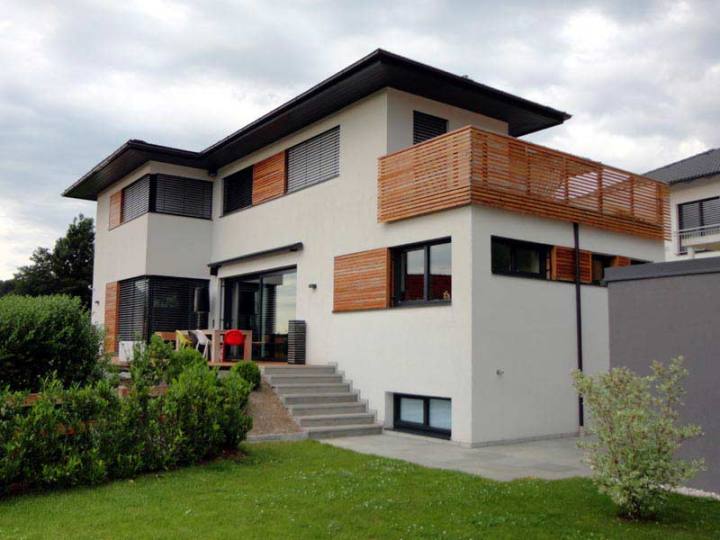
Types of roofs: video
As you can see, if you are wondering how to build a house, you will have to solve many more additional questions. A little final tip - if the budget is limited, give preference to a house with a simple geometric shape (square, rectangle), because. the presence of extra corners and bay windows leads to a sharp rise in the cost of the entire construction.
erection two-storey houses quite often practiced, since a very spacious building can be obtained on a relatively small area. Such structures are becoming more popular, and the use modern technologies allows you to create a truly unique building.
We start construction
The process of building two-story houses is practically no different from the construction of ordinary one-story buildings. This procedure is quite complicated and consists of many steps:
- First of all, you need to decide on the type of structure and select the main materials. In this case, it should be borne in mind that the structure will be quite overall and all its parts must accordingly withstand the load.
- The next step is building the foundation. For these types of houses, it is desirable to give preference to strong foundations that can withstand future loads. The simplest option is to lay a strip foundation with the appropriate parameters.
We continue to build
When the foundation is ready, we proceed to the construction of the walls. As the main material, you can choose a foam block. This material is able to withstand high loads, while it has high rates of heat retention.

Before erecting walls, it is imperative to provide for the possibility of waterproofing the foundation from the base substance. To do this, use the usual roofing material. After that, you can start building walls.
This procedure is relatively simple. In this case, you must first take into account the location of all doors and windows and, according to the scheme, carry out installation.
When the first floor is ready, it should be possible to organize an overlap for the second floor. As the main material here can be used wooden beams certain thicknesses or metal structures. It all depends on the type of your building.
After that, the construction of the second floor is carried out in the same way. Upon completion, they begin to arrange the roof, which can be done in several ways.
When building a two-story house, you must first take into account the option for arranging the stairs and select materials for its construction.
When the base is ready, you should proceed to the internal and exterior finish. At this stage, walls and roofs are insulated, floors are laid, door and window openings are installed.
Also, one should take into account the possibility of organizing heating and connecting other communications.
And in this video, a specialist will explain which house will cost less, one- or two-story:
A lot of buildings are now being built from foam blocks, especially in suburban construction. The project of such a building will make it possible to build a house of a large area even on small area and favorably position the rooms.
As a rule, common rooms are located on the first floor: a kitchen, a living room, a dining room, and on the second floor there are bedrooms and children's rooms. Small two-story houses made of foam blocks are relatively inexpensive, and are built much faster than brick ones.
Photo of a two-story house made of foam blocks lined with bricks 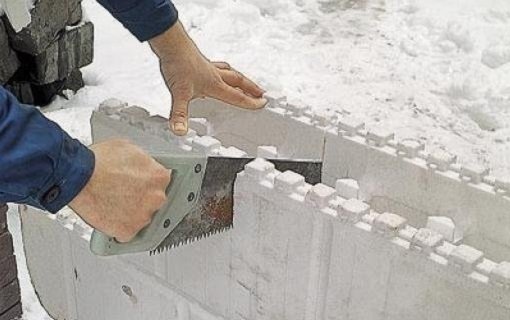
- Foam blocks are made of foamed cellular concrete, which has a sufficiently high strength and is convenient in construction;
- The blocks are well shaped and easy to cut. They are larger in size than a brick, which allows you to speed up the construction of walls;
- They can be easily combined, which allows you to build a variety of buildings according to individual projects. Finding such projects of two-story houses made of foam blocks for free is not difficult now, as foam concrete is becoming more and more popular;
- The material is made from natural raw materials, so it is environmentally friendly;
- The house will have a pleasant atmosphere, since foam concrete has the ability to "breathe". The thermal conductivity of the foam block is quite low.
- The foundation for a two-story foam block house may not be particularly strong, since they themselves are light in weight.

HOW TO DEVELOP A PROJECT FOR BUILDING A HOUSE?
Let's consider in more detail how to build a two-story house from foam blocks with your own hands in order to ensure minimal costs, and as a result get a spacious and warm house that meets all safety requirements.
Work begins with design. You can choose an already developed project, of which there are quite a lot on the Internet, or you can draw up your own plan that will allow you to build a unique and inimitable house.
The project of a two-story foam block house begins with planning its placement on the site. It is necessary to determine the sunny and shady sides, keeping in mind that large windows on the sunny side provide not only good illumination, but also reduce heating costs.
Consider the size of the future home in accordance with financial capabilities. The project of a 9x9 two-story house made of foam blocks is a typical convenient solution, since such dimensions make it possible to conveniently plan rooms on the first and second floors.
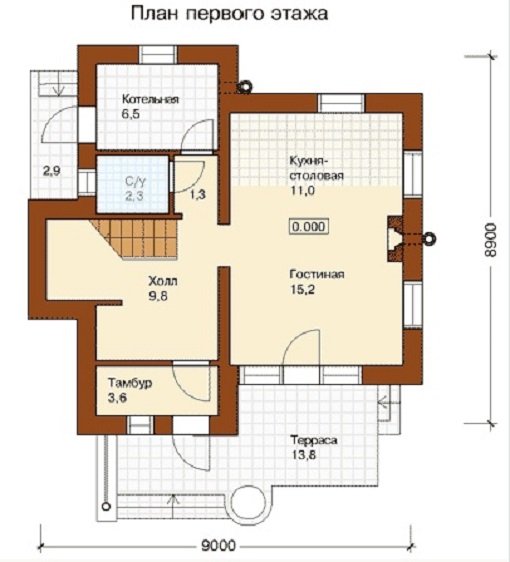
An individual project allows you to include an attic, an attached garage, a usable basement in which you can place anything from a workshop to a personal gym.
The attic room will allow you to equip those rooms for which there is no place in an ordinary house: a billiard room, a library, a studio for creativity. The installation of special windows in it will provide optimal natural light.

STAGES OF WORK ON THE PROJECT
Designing a house is best done in consultation with a professional architect. This is a rather difficult and responsible job, since the convenience, durability and practicality of the future home will ultimately depend on it. The drafting of the project takes place in several stages, in which it is necessary to comply with the main rules and building codes.
The main part of the design
When working on a project, it is important to consider several patterns. Approximate design instructions:
- When designing the foundation, the composition of the soil and the depth of occurrence must be taken into account. ground water. It will not be superfluous to consult with specialists and conduct a geological examination in advance;
Advice! It is worth thinking about the insulation of the foundation, especially if the house is planned to be built on heaving soils. When the soil freezes, it expands and will put pressure on the foundation, which can eventually cause cracks.
- The most important step is the calculation of the wall thickness. According to building codes, 10 mm masonry can withstand a weight of about 10 tons, and it is necessary to calculate the weight of floors and roofing materials. The thermal insulation properties of foam concrete are high, and in the absence of additional insulation, 300 mm thick walls will be enough for a completely comfortable house. According to its properties, it will not yield to a brick building, it will even be warmer in it;
- Together with all family members, imagine how many rooms you plan to have in your house, and how they should be located. It is worth considering all the needs and wishes, for example, rooms for older family members are best located on the ground floor. If you are proficient with modern computer modeling programs, you can take a virtual "walk" through your future home to make sure it will really be comfortable.
- Consider the location of door and window openings and mark them on the plan. Imagine how illuminated the rooms will be, whether it will be convenient to pass from one room to another. Another important point is the location of the stairs to the second floor. It can be straight or curved, and it is important that the steps are not too steep.
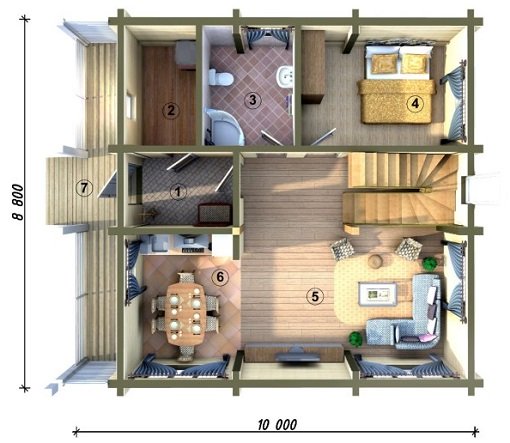
Having decided on the location of the rooms, select the appropriate roofing material. Do not forget that most of the heat goes through the roof of the building, so you should take care of multi-layer insulation.
The floor in the building must also be insulated, for which you can use either traditional materials, or plan to create a "warm floor" using water or electricity.
Planning of finishing materials
You can start planning the finishes. There can be many options here, and the final choice will depend solely on personal preferences and financial capabilities.
You can find out how much it costs to build a two-story house from foam blocks by adding up the cost of the building materials needed to build the building and the cost of paying employees and equipment.
When drawing up an estimate, it is worth consulting with professional builders and be sure to include in the calculations at least a small percentage of the overrun of materials.
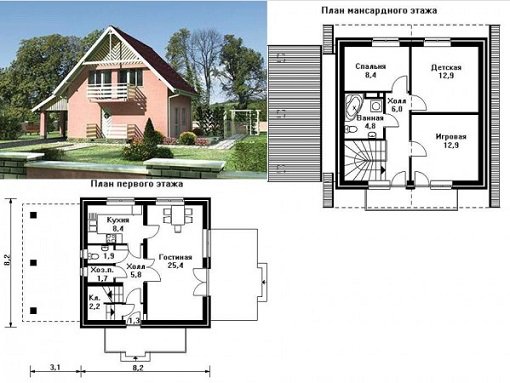
Two-story houses made of foam blocks, the projects of which can be found on the Internet, involve the use of facing bricks, tiles, siding or other options that have very different costs for exterior decoration.
One of the popular options is facade plaster, which further enhances the sound and heat insulation properties of the house. In interior decoration There are even more varieties of materials, and here, when choosing, you must simultaneously focus on their operational and design properties.
Communication planning
Another important part of the design is the location of utilities in the house and on the site. Modern houses are supplied with plumbing and a drainage system, and the layout of the pipes should be taken into account in future construction works Oh.
 Engineering communications project
Engineering communications project It is necessary to consider how it is more profitable and economical to lay pipes on the site, from which side it is more convenient to bring electrical wires, whether gasification is planned.
Important! It is imperative to design ventilation ducts, since the atmosphere in the room and its safety will depend on them.
When the planning work is completed, it is worth double-checking all the key elements and making sure that none of them have been left unattended. After that, you can purchase materials, mark the site and begin construction.
landscape design
The final stage of design - thinking through the future landscape design and placement of economic facilities. You can draft a two-story foam block bath, as this material will provide good thermal insulation, and its price is low.
All structures on the site must be placed in compliance with sanitary and fire safety standards. Consider the location of the tracks and the possible zoning of the territory.
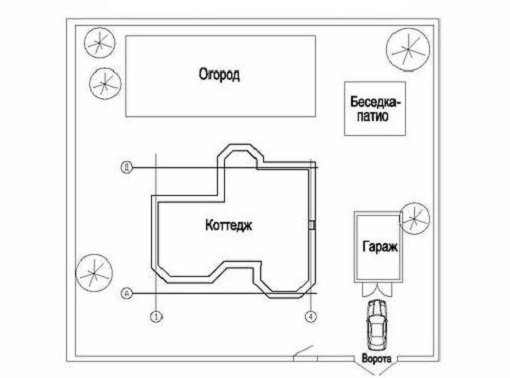 Landscape Project Example
Landscape Project Example CONCLUSION
Self-projecting a house is very difficult task, but with some preparation, it will be quite within the power of a novice builder. Think through all the options and, if possible, consult with experts at each stage. Then the house will really be both durable and comfortable.
A spacious house, to the last detail corresponding to a personal ideal, is a dream. It is impossible to buy such a house, it can only be built. Practice shows that it does not matter whether the construction of a two-story house will be carried out with your own hands, or by the construction team, personal control at each stage of work cannot be avoided. By the end of construction, all homeowners thoroughly know the technical aspects of construction. But the Dream House is received only by those who have mastered the theoretical base in advance.
Step one - site selection
Plots without flaws, on which you can build a two-story house, are rare, in life you always have to find a compromise. The location of the site is evaluated in terms of whether it will be convenient to get there and how long the daily journey will take. The hilly terrain of the site can complicate construction. erection of retaining walls, pile foundation increases complexity and cost.
It is preferable to have communications - electricity, gas pipeline, water supply, sewerage. If there is no centralized network, the cost of installation and maintenance of a well, power plant, solid fuel or electric boiler is calculated. The depth of occurrence and the quality of groundwater are taken into account. You can get rid of solving these complex issues in a simple way: buy a house in a cottage village, for example, http://berezka4s.ru/houses/. In such types of housing, all the amenities of life have already been thought out. The truth is, you have to pay for everything.
Step two - paperwork
Before the start of construction work, it is necessary to correctly draw up construction documents. They are received in the following order:
- Design permit - obtained from the local executive authority;
- Architectural and planning task - issued by the Department of Architecture;
- Specifications of providers of water and gas supply services, power networks;
- House project - created individually or bought ready-made http://proekt-sam.ru/;
- Examination and approval of the project;
- Building permit.
Choice two-story project allows you to get a large area of \u200b\u200bthe house with an equal building area.
Step three - arranging the foundation
Before starting work, it is necessary to ensure the availability of water and electricity on the site. The external and internal contour of the foundation is marked on the site, carefully maintaining the accuracy of the angles. The optimal type of foundation is determined by the load that it has to withstand and the properties of the soil:
- Tape;
- Monolithic-slab;
- Columnar;
- Pile.
The strip foundation is suitable for the construction of a two-story house from all types of material. Its use is limited by swampy, unstable soils and surface occurrence of groundwater. A trench is dug to build the foundation. The optimal depth of the strip foundation is 0.8 m per floor of the house, and with a two-story building it should be more than 1.6 m. A gravel-sand cushion 30 cm thick is arranged in the trench from equal layers of compacted sand and crushed stone. Then the formwork of a given width is mounted. For the convenience of creating formwork, the width of the trench should be 50 cm greater than the width of the foundation.
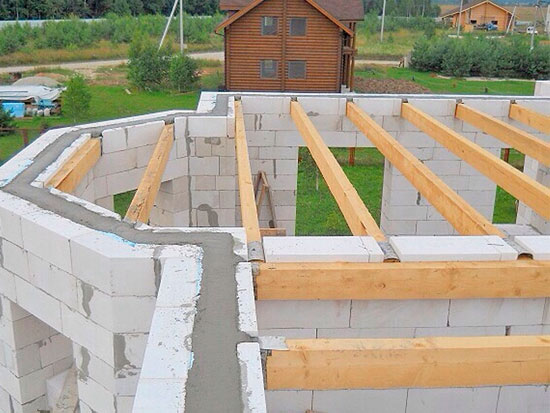
It is desirable to create a belt of cement mortar with a thickness of 10 cm. The formwork contains a reinforcing frame of horizontal and vertical chords fixed with knitting wire. Before concrete works establish mortgages for the subsequent laying of communications. The formwork is ready for concrete pouring. Filling must be done in one step to avoid butt joints that reduce the strength of the structure. Before hardening, concrete is compacted with a construction vibrator, eliminating air pockets. The formwork can be dismantled after the concrete has gained primary strength, after 5-7 days. The foundation is waterproofed with bituminous mastic, roll materials or spray formulations.
The columnar foundation is more economical, but is suitable only for objects made of light materials - wooden or frame houses. Foundation pillars are built in places where the load is concentrated - the corners of the house, the intersection of walls, load-bearing walls. The distance between the pillars is 2-2.5 m. They are made of concrete, wood, brick or rubble-concrete mixture. Wood for poles is treated with antiseptic solutions. Along the contour of the foundation, a binding of brick or concrete is carried out, with a height of ¼ of the span length.
Foundation in the form of a monolithic concrete slab it is used in the surface occurrence of groundwater and the construction of heavy buildings on unstable soils. It is rarely used in private buildings.
The pile foundation is suitable for construction in areas with complex terrain or deformable soil. For such a foundation, piles are screwed or driven into the ground, and a monolithic connecting belt is formed along the perimeter, as in the arrangement of a columnar foundation.
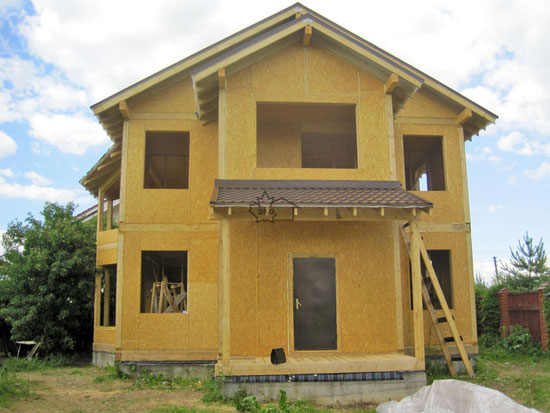
Step Three - Building the Walls
Wall construction technology depends on the material chosen. As a material for the construction of a two-story residential building use:
- Wood - chopped or rounded logs, wooden beams - sawn, planed, profiled or glued;
- Brick - ceramic, clinker, silicate, facing;
- Ceramic blocks;
- Lightweight concrete blocks - gas and foam concrete;
- Thermoblocks;
- Limestone-shell rock;
- Frame structures.
When deciding how to build a two-story house with your own hands, it should be noted that it is impossible to build wooden walls alone.
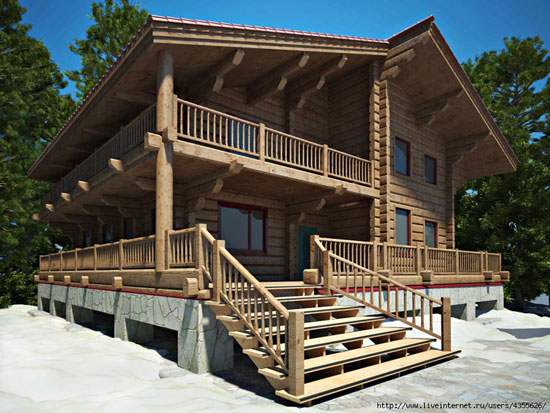
Regardless of the material chosen, during the construction process, they control the observance of angles, verticals and horizontals. During the construction of walls, voids are formed in the places of door and window openings, over which wooden, metal or reinforced concrete lintels are installed. The lintels are laid into the wall by 20-25 cm. Upon reaching the required floor height, a reinforced concrete or brick armored belt is constructed, which takes on the weight of the ceilings and protects the wall material from damage.
Step three - interfloor and attic flooring
The ceiling is made of wood, monolithic or slab reinforced concrete. material to create hardwood floor serve as beams impregnated with an antiseptic solution. The step of the beams is calculated taking into account the upcoming load to exclude surface deformation during operation. The space between the beams is filled with thermal insulation material, which performs the function of sound absorption in the interfloor ceilings. The distance between the beams is carried out by boards or shields. Reinforced concrete floor made from monolithic reinforced concrete slab or prefabricated boards.
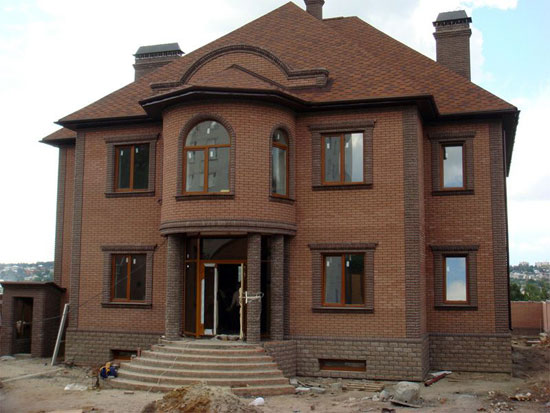
Regardless of the material of the ceilings, technological openings for ventilation and smoke ducts are equipped in them. In the interfloor overlap, an opening for the stairs is provided. The staircase is attached to load-bearing walls and is designed as a single-flight or two-flight. With a small size of the room, which does not allow to place a mid-flight staircase, a screw design is preferred. In this case, the place of the stairwell in the ceiling may not adjoin the wall. If the project provides for a balcony, then interfloor overlap must extend beyond the outer walls in appropriate places.
Step four - roofing
When choosing how to build a two-story house, take into account that complex multi-level roofs increase the visual appeal of the object. Wooden structural elements are treated with an antiseptic before installation, and after - with antipyretic impregnations. On the reinforcing belt, made along the perimeter of the walls of the house, a wooden strapping is attached with anchors - Mauerlat, to which the rafter system is fixed.
The pitch of the rafters and their cross section are calculated at the design stage. Depending on the roofing material used, a crate of bars (for slate or metal tiles) or a solid crate of moisture-resistant plywood (for bituminous tiles) is mounted. A roofing material with preliminary waterproofing is mounted on the crate, if the technology requires it. Snow-retaining barriers are installed on the metal tile. A drainage system is installed around the perimeter of the house.
Step five - arranging the blind area
To protect the foundation, it is necessary to level the soil with a slight (up to 5 cm) depression. Concrete is poured in a layer of about 8 cm with a slope in the direction from the wall within 3-5ᵒ. At the same time, a drainage system is installed in the blind area.
Five steps to the Dream House completed. Although this is only the beginning of the journey, and the difficulties of interior work lie ahead, but now you know exactly how to make a two-story house. Unless, of course, the article was read before construction.
Two-story houses were almost always and everywhere in vogue. In the Soviet era, it was very difficult for an ordinary citizen to build a two-story house for personal use, both materially and socially. Housing was most often very limited, not in the worst case, you had to live in a small one-room apartment. It’s scary for many to even talk about living in a communal apartment now.
One way or another, two-story houses are now being built quite often. Of course, the costs of building materials and labor are considerable, but they are worth it. Anyone who cannot afford to build a two-story building for himself and his family in one go is “built” for some line. Such construction can take up to ten years, depending on financial capabilities, the desire of the owner and other reasons. Many resort to a more cunning way - they build two-story houses together with several owners. This is usually two or four hosts. But the latter version of the building can be more likely identified with a small apartment building than an individual property. Business people prefer two-story buildings. It is also good and practical to build a two-story house from timber or aerated concrete, but this is a separate topic for conversation.
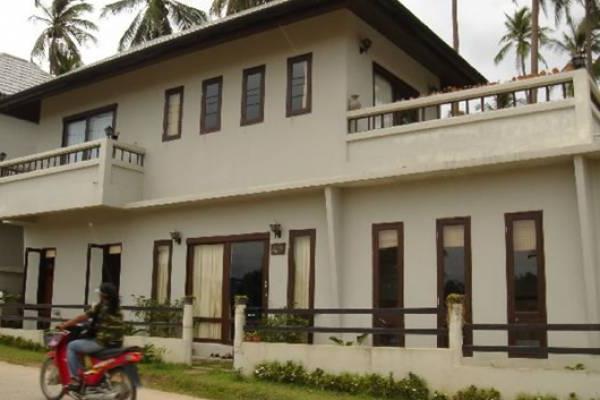 A good option is the implementation of the restructuring. At the same time, two-story houses for individual purposes are built by attaching the second floor to one-story building. Thus, significant savings in effort and money are achieved. There are a number of advantages that attract people who do not like a quick change of scenery in the house. However, there are also some limitations. So, for example, if the building is quite old, then in some cases it is necessary to strengthen some of its details (foundation, beams, etc.). Two-story buildings built in this way are often equipped with interior walls drywall or other lightweight material. This is necessary to limit the load on the load-bearing elements of the building. Of course, at best, its frame also has to be significantly re-equipped, but basically the roof is completely replaced. For this purpose, as a rule, it is installed with a slope, from a light material, most often it is a thin and slightly corrosive metal. Tiling or something similar is less suitable, because it makes the roof more massive.
A good option is the implementation of the restructuring. At the same time, two-story houses for individual purposes are built by attaching the second floor to one-story building. Thus, significant savings in effort and money are achieved. There are a number of advantages that attract people who do not like a quick change of scenery in the house. However, there are also some limitations. So, for example, if the building is quite old, then in some cases it is necessary to strengthen some of its details (foundation, beams, etc.). Two-story buildings built in this way are often equipped with interior walls drywall or other lightweight material. This is necessary to limit the load on the load-bearing elements of the building. Of course, at best, its frame also has to be significantly re-equipped, but basically the roof is completely replaced. For this purpose, as a rule, it is installed with a slope, from a light material, most often it is a thin and slightly corrosive metal. Tiling or something similar is less suitable, because it makes the roof more massive.
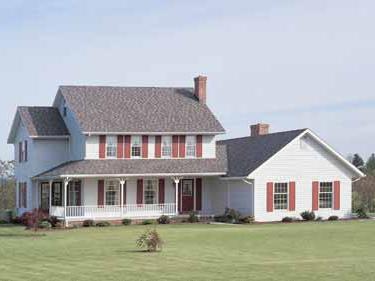 It is also worth seriously approaching the insulation of a two-story house. This applies to both internal heating system, and direct insulation of walls, roofs. Autonomous gas heating is most suitable. Heating a two-story house in another way (for example, with firewood) is quite unprofitable economically and physically difficult. For drywall and other materials, and for external work - foam, etc. In addition, it makes it possible to design at the discretion of the owners and in almost any color scheme. Heat retention is also largely dependent on roof insulation, for which glass wool and other insulating materials are used.
It is also worth seriously approaching the insulation of a two-story house. This applies to both internal heating system, and direct insulation of walls, roofs. Autonomous gas heating is most suitable. Heating a two-story house in another way (for example, with firewood) is quite unprofitable economically and physically difficult. For drywall and other materials, and for external work - foam, etc. In addition, it makes it possible to design at the discretion of the owners and in almost any color scheme. Heat retention is also largely dependent on roof insulation, for which glass wool and other insulating materials are used.
Before starting the construction of an individual residential two-story house, it is necessary to evaluate all the details, primarily based on economic considerations. Although for a person who has set a goal, the latter will rarely become an obstacle in the construction of a cherished home. But it is also worth considering that sometimes it is easier to buy a house ready, without creating unnecessary problems for yourself.



